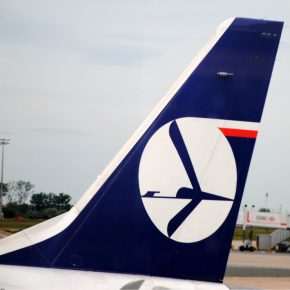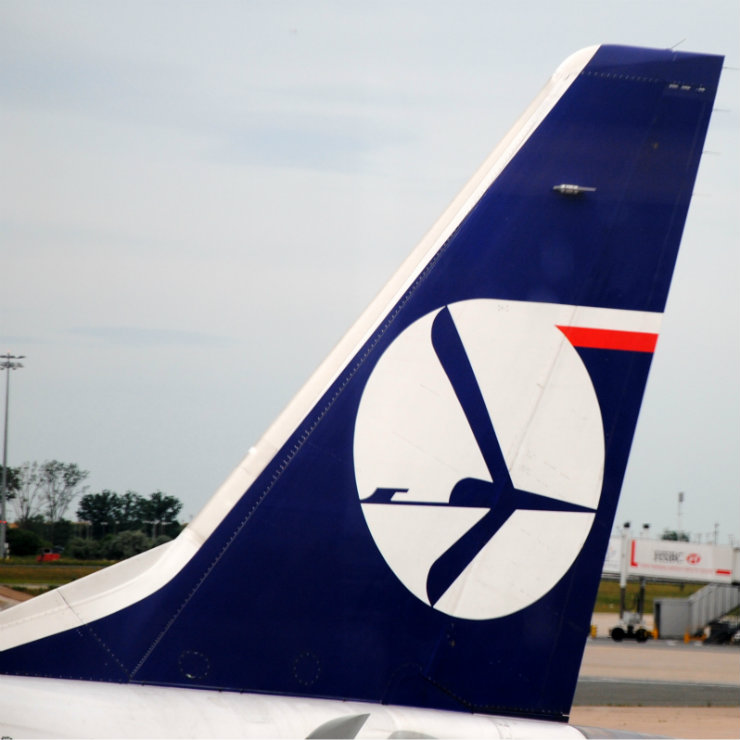
(Leandro Ciuffo, CC BY 2.0)
Wizz Air, Europe’s „greenest” airline and a leading low-cost airline in Central and Southeast Europe (CSE), has been selected as Europe’s Best Low-Cost Airline in 2020 on the annual list of AirlineRatings, the world’s only website specializing in safety and product evaluations. This list is considered one of the most important and respected in the aviation world, with prominent airlines among the early winners. This is the second year in a row that the Budapest-based Wizz Air has won.
The Airline of the Year Awards is presented to the best among the best in the airline industry and help travellers choose the safest and best airlines to fly. In addition to superior flight service, the world’s best airlines need to be innovative and have a well-developed destination network and a high level of security. All awards are given based on the strict criteria of the Airline ratings web site editor.
„We are delighted to have won this prestigious award. It reaffirms Wizz Air’s commitment to travellers through its continued investment in improving the travel experience, the lowest possible airfare and the growing network of travel options available. We will continue to explore new horizons and operate responsibly based on our ULCC business model to have a fleet of 300 highly efficient modern aircraft. Our friendly staff will be delighted to welcome you to one of our young and modern aircraft, „said Stephen Jones, Executive Vice President and Deputy CEO of Wizz Air.
National CSE carriers are struggling but Polish LOT
When considering the CSE market, the low-costs airlines have a visible advantage. This is nothing new. In a complex and ever-challenging web of regional competition for the ever cheaper and ever faster air travel, the national carriers are constantly losing the battle with the low-cost airlines. Still, there are strategies employed by some flag carriers that are a recipe for survival. For the past 3 years, LOT Polish Airlines has been the fastest-growing airline in Europe, increasing by 30 per cent per year. In 2015 it carried 4.3 million passengers, in 2018, they reached 8.9 million passengers. The state-owned PLL LOT oriented itself to more long-haul flights and regional destinations. In August 2018, the Croatian government proposed that LOT take over Croatia Airlines, and there is a similar interest from the Romanian TAROM. LOT has a very vivid new hub in Budapest until a new USD10bn airport replaces the Warsaw’s Chopin. This will bring between 45 and 100 million passengers a year, depending on the success of a new planned hub (and in competition with Helsinki, where Finnair plans to make a Dubai-style hub of the North). In 2018, PLL LOT was the fastest-growing airline in the CSE’s top ten, and now it has plans to replace its problematic Boeings with the new Airbus A220s and A350s, as an addition to long haul aircraft serving the destinations in Asia. On top of that two Polish airports are the only CSE ones ranked in the Global Airport Ranking 2019 by AirHelp Score. The Gdansk airport (northern Poland) is the 5th best airport in the world, and Warsaw’s Chopin airport is the 56th.
Other airlines are trying to survive more or less successfully. The fifth-oldest, still functioning airline in the world, the ČSA Czech Airlines experiences steady increase in the total net income, but with fewer aircraft and damaged reputation. The ČSA now operates as the Czech SmartWings, which was included in the 21 worst airlines list by Travel Service since 2016. Last year, Czech Airlines ranked 59th out of 72 rated airlines on AirHelp’s ranking. The Czech Prime Minister Andrej Babiš announced a major expansion of Prague Airport with USD400m in the first phase that should end in 2025. Additionally, SmartWings operates most of the air travels in neighboring Slovakia, through the subsidiary SmartWings Slovakia.
The Romanian TAROM has not made a profit for eleven consecutive years and has management problems. TAROM is a state-owned airline, which is probably why it is still in business today. “The airlines are expected to have RON190m (EUR40m) loss,” Romanian Transport Minister Lucian Bode has recently said. “Things look very bad at Tarom, we have only around EUR20m available on our accounts at this moment. We have instalments to pay to Boeing, we are considering the acquisition of ATR aircraft, according to the memorandum we have signed, so it is clear that we need to modernize the fleet,” Mr. Bode explained and added that Tarom needs a very well defined restructuring program. Romania will apply for the EU aid of EUR47m plus a restructuring aid of about EUR110m will come from the state budget in order to rescue the company. A similar situation occurs with the Bulgaria Air, which narrows its net losses for several years now. It increased the number of passengers but with fewer flights, and international flights fell 2 per cent y/y but the regular domestic flights grew 12 per cent.
By far the most dominant carrier in the region of former Yugoslavia is Air Serbia. It is one of only three successful Etihad partnerships and probably one with foreseeable future. In the summer season, Air Serbia launched 21 new routes and it opens new airport base in Kraljevo, next to the Nikola Tesla airport in Belgrade and Constantine the Great airport in Niš. As a consequence, the Serbian national carrier recorded a net profit of EUR12,2m in 2018, while revenues reached EUR288m. It is a decrease, but still it’s the second-best financial result since Air Serbia’s relaunch in late 2013.
All other regional flag carriers are experiencing a hard time. After a dreadful few years, the national airline of Slovenia, Adria Airways, finally closed its doors. It went bankrupt in a month that saw the end of legendary Thomas Cook Airlines; the market has no sentiment for traditions. Croatia Airlines had a net loss of EUR10,7m last year and already EUR12,1m in the first half of 2019, albeit an increased expenditure (increased benefits for cabin crew, maintenance, promotion). A good future is foreseen for Croatia’s coastal airports, particularly Dubrovnik, Split and Zadar, but Zagreb stagnates in a number of passengers. The Franjo Tuđman airport is simply too expensive, it has just 45 flights per day, which is the lowest among the European capitals.
Bosnia and Herzegovina does not have a national airline. The only local airline is FlyBosnia, which is a charter airline connecting Sarajevo with Middle Eastern destinations – and generating losses and debts to the Sarajevo International Airport. Montenegro Airlines, the only Montenegrin airline offering regularly scheduled services, has difficulties in maintaining its fleet and paying its debts. Macedonia has no active airlines, while Kosova Airlines exist but have no fleet since 2006. And in Albania, after the closing down of the Albanian Airlines in 2011, the Turkish Airlines invested in creating the Air Albania, which started operating in May 2018.
Ailing flag carriers are having a hard time worldwide. They are struck by technical demands, labor deals, and large subsidies from the owner, which is in many cases the state. Intense low-cost competition and increased costs are a huge challenge for management as they seek a way to continue flying. There is a segment of flair and style of a national airline, which serves as a proudly representative and image-maker of a country. It is an important link to the outside world and it may even have a large national interest component; such airlines are the Russian national carrier Aeroflot, the Emirates, the British Airlines, the Turkish Airlines and the Ethiopian Airlines. The vast number of their destinations serve as a soft power and gives a particular brand with flight attendants speaking the same language as the country itself does.
Wizz Air as the most successful airline in the CSE
Their biggest competition is still the low-cost airlines, but in the past couple of years, the majority of all the airline bankruptcies have been in the low-cost sector (for instance, one should only look at Air Berlin, Monarch, Primera, Flybmi, etc). Ryanair, EasyJet and Wizz Air all have their problems, but many other smaller airlines are not so lucky and have not achieved a real success. The tickets in these airlines are almost for free, particularly when they are given for the incredible price of EUR9,99. The profits are in the ancillary sales, where everything except for the unassigned seat comes with charges. However, there is statistically not yet approved feeling that for every new destination, a low-cost airline terminates two existing ones. For instance, Ryanair has been flying to 60 destinations less in 2018 than in a year before. In late 2019 and in 2020, Wizz Air will open just three new destinations: Brussels, Zaporizhia and Edinburgh, but since 2011, it closed down 42 destinations, including some major ones, such as: Zagreb, Hurghada, Helsinki, Cork, Venice, Amsterdam, and Istanbul. In times of global fuel rise and rising wages, low-costs are simply not profitable.
The Wizz Air is a big exception in the low-cost airlines, though. It may not be serving bigger destinations, but has a huge network of small airports in regional areas. The forecast for 2019 was that it may serve more than 40 million passengers. The most interesting fact is that Wizz Air ordered 269 new aircraft, more than any other carrier in Europe, bypassing Lufthansa which has ordered 208 aircrafts. The most successful CSE low-cost airline has ordered 70 A320n, 179 A321n and 20 A321XLR (intended for routes to Dubai, London, but possibly also to India and North America), further boosting the Airbus’ production. This means that Wizz Air is taking a step further from a successful airline serving the Eastern European diaspora in Western Europe.


